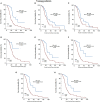Role of leukocytes and systemic inflammation indexes (NLR, PLR, MLP, dNLR, NLPR, AISI, SIR-I, and SII) on admission predicts in-hospital mortality in non-elderly and elderly COVID-19 patients
- PMID: 36059829
- PMCID: PMC9434555
- DOI: 10.3389/fmed.2022.916453
Role of leukocytes and systemic inflammation indexes (NLR, PLR, MLP, dNLR, NLPR, AISI, SIR-I, and SII) on admission predicts in-hospital mortality in non-elderly and elderly COVID-19 patients
Abstract
Background: Systemic inflammation indices, including neutrophil/lymphocyte ratio (NLR), monocyte/lymphocyte ratio (MLR), platelet/lymphocyte ratio (PLR), derived neutrophil/lymphocyte ratio (dNLR), neutrophil/lymphocyte*platelet ratio (NLPR), aggregate index of systemic inflammation (AISI), systemic inflammation response index (SIR-I), and systemic inflammation index (SII) are well-expressed inflammatory indices that have been used to predict the severity and mortality of various inflammatory diseases. This study aimed to investigate the role of systemic inflammatory markers in predicting mortality in non-elderly and elderly COVID-19 patients.
Methods: In a retrospective study, laboratory parameters were examined for 1,792 COVID-19 patients (elderly = 710 and non-elderly = 1,082). The ability of inflammatory markers to distinguish the severity of COVID-19 was determined by receiver operating characteristic (ROC) analysis, and survival probability was determined by the mean of Kaplan-Meier curves, with the endpoint being death.
Results: In the non-survivor non-elderly and elderly patients, the parameters PLR, MLR, dNLR, NLPR, AISI, SIR-I, and SII were significantly higher than in the surviving patients. WBC count (HR = 4.668, 95% CI = 1.624 to 13.413, P < 0.01), neutrophil count (HR = 6.395, 95% CI = 2.070 to 19.760, P < 0.01), dNLR (HR = 0.390, 95% CI = 0.182 to 0.835, P < 0.05), and SII (HR = 10.725, 95% CI = 1.076 to 106.826, P < 0.05) were significantly associated with survival. On the other hand, in elderly patients, it was found that WBC count (HR = 4.076, 95% CI = 2.176 to 7.637, P < 0.001) and neutrophil count (HR = 2.412, 95% CI = 1.252 to 4.647, P < 0.01) were significantly associated with survival.
Conclusion: WBC count and neutrophil count in non-elderly and elderly patients, were reliable predictors of mortality.
Keywords: COVID-19; aging; coronavirus; inflammation; systemic inflammation index.
Copyright © 2022 Ghobadi, Mohammadshahi, Javaheri, Fouladi, Mirzazadeh and Aslani.
Conflict of interest statement
The authors declare that the research was conducted in the absence of any commercial or financial relationships that could be construed as a potential conflict of interest.
Figures



References
LinkOut - more resources
Full Text Sources

